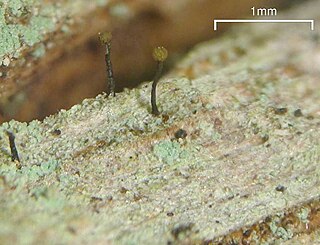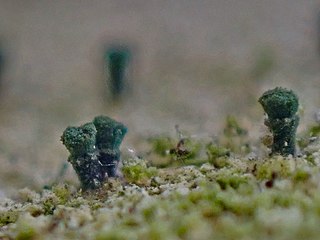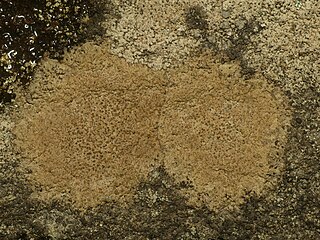
Eurotiomycetes is a large class of ascomycetes with cleistothecial ascocarps within the subphylum Pezizomycotina, currently containing around 3810 species according to the Catalogue of Life. It is the third largest lichenized class, with more than 1200 lichen species that are mostly bitunicate in the formation of asci. It contains most of the fungi previously known morphologically as "Plectomycetes".

Chaenotheca is a genus of lichenized fungi within the family Coniocybaceae. The sexual reproduction structures are a mass of loose ascospores that are enclosed by a cup shaped exciple sitting on top of a tiny stalk, having the appearance of a dressmaker's pin, hence the common name pin lichen. Genus members are also commonly called needle lichens.

The Arthoniales is the second largest order of mainly crustose lichens, but fruticose lichens are present as well. The order contains around 1500 species, while the largest order with lichenized fungi, the Lecanorales, contains more than 14000 species.

The Graphidaceae are a family of lichen-forming fungi in the order Graphidales. The family contains nearly a hundred genera and more than 2000 species. Although the family has a cosmopolitan distribution, most Graphidaceae species occur in tropical regions, and typically grow on bark.

Nadvornikia is a genus of lichen-forming fungi in the family Graphidaceae. Species in the genus are corticolous (bark-dwelling) and crustose.

Calicium is a genus of leprose lichens. It is in the family Caliciaceae, and has 40 species.
Clavascidium is a genus of lichens in the family Verrucariaceae. The genus was circumscribed in 1996 by Austrian lichenologist Othmar Breuss. Because the type species of the genus, Clavascidium umbrinum, has been shown using molecular phylogenetics to belong to genus Placidium, Cécile Gueidan and colleagues proposed to unite Clavascidium with Placidium in a 2009 publication. Despite this, the genus has been retained in recent publications of fungal classification.
Henrica is a genus of crustose lichens in the family Verrucariaceae. It has four species. The genus was circumscribed by Maurice Bouly de Lesdain in 1921, with Henrica ramulosa assigned as the type species. The generic name Henrica honours Italian clergyman and lichenologist Joseph-Marie Henry (1870–1947).

The Coniocybaceae are the sole family of lichen-forming fungi in the Coniocybales, which itself is the only order in the class Coniocybomycetes. The family was circumscribed by Heinrich Gottlieb Ludwig Reichenbach in 1837. Both the order and the class were proposed by Maria Prieto and Mats Wedin in 2013 after molecular phylogenetics analysis of various calicioid lichens showed that the Coniocybaceae represented an early diverging lineage in the inoperculate ascomycetes.

Microcalicium is a genus of lichen-forming fungi in the order Pertusariales. It is the only genus in the monotypic family Microcaliciaceae. These taxa were circumscribed by the Finnish lichenologist Edvard August Vainio in 1927, with Microcalicium disseminatum assigned as the type species.
Tylophoron is a genus of lichen-forming fungi in the family Arthoniaceae. The genus was circumscribed in 1862 by Finnish lichenologist William Nylander.

Chaenothecopsis is a genus of about 40 species of pin lichens in the family Mycocaliciaceae. Many of the species are resinicolous, meaning they grow on conifer resin or other plant exudates. Most common host plants are trees in the genera Abies, Picea, and Tsuga.

Phaeocalicium is a genus of fungi in the family Mycocaliciaceae. The genus was circumscribed in 1970 by German lichenologist Alexander Schmidt, with Phaeocalicium praecedens assigned as the type species.
Stenocybe is a genus of fungi in the family Mycocaliciaceae. It has 14 species.
Wegea is a genus of fungi within the order Arthoniales. The genus has not been placed into a family. This is a monotypic genus, containing the single species Wegea tylophorelloides. The genus was circumscribed in 1997 by André Aptroot and Leif Tibell. The species have a morphology similar to calicioid fungi but does not form a mazaedium.

The Caliciaceae are a family of mostly lichen-forming fungi belonging to the class Lecanoromycetes in the division Ascomycota. Although the family has had its classification changed several times throughout its taxonomic history, the use of modern molecular phylogenetic methods have helped to establish its current placement in the order Caliciales. Caliciaceae contains 39 genera and about 670 species. The largest genus is Buellia, with around 300 species; there are more than a dozen genera that contain only a single species.

Caliciales is an order of mostly lichenized fungi in the class Lecanoromycetes. It consists of two families: Caliciaceae and Physciaceae, which together contain 54 genera and more than 1200 species. The order was circumscribed by American botanist Charles Edwin Bessey in 1907.
Atla is a genus of crustose lichens in the family Verrucariaceae. It has nine species that grow on rocks or on soil.

Lobaria anomala, commonly known as the netted specklebelly, is a species of foliose lichen in the family Peltigeraceae. It is found in coastal western North America, where it grows on trees in humid environments.

Ionaspis is a genus of lichen-forming fungi in the family Hymeneliaceae. It contains six species of saxicolous (rock-dwelling), crustose lichens. The genus was originally circumscribed in 1871 by Theodor Magnus Fries. He segregated the genus from Aspicilia based on the presence of Trentepohlia rather than Trebouxia as the photobiont partner.












